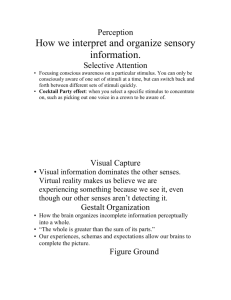perceptual interpretation & illusions
advertisement
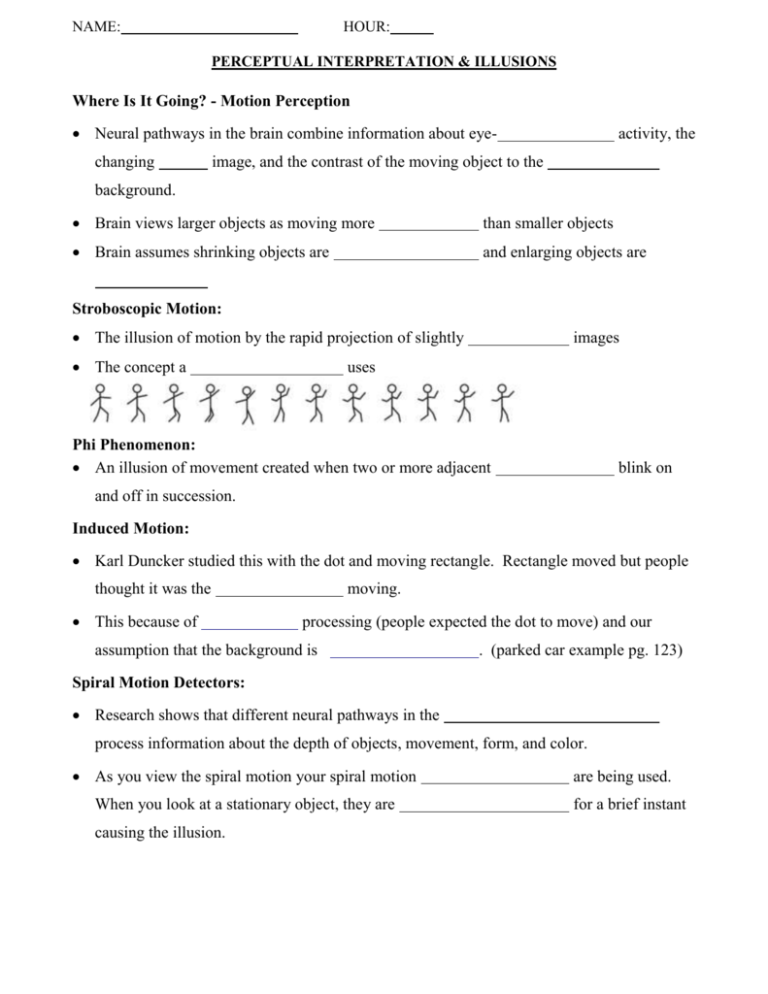
NAME: HOUR: PERCEPTUAL INTERPRETATION & ILLUSIONS Where Is It Going? - Motion Perception Neural pathways in the brain combine information about eyechanging activity, the image, and the contrast of the moving object to the background. Brain views larger objects as moving more than smaller objects Brain assumes shrinking objects are and enlarging objects are Stroboscopic Motion: The illusion of motion by the rapid projection of slightly The concept a images uses Phi Phenomenon: An illusion of movement created when two or more adjacent blink on and off in succession. Induced Motion: Karl Duncker studied this with the dot and moving rectangle. Rectangle moved but people thought it was the This because of moving. processing (people expected the dot to move) and our assumption that the background is . (parked car example pg. 123) Spiral Motion Detectors: Research shows that different neural pathways in the process information about the depth of objects, movement, form, and color. As you view the spiral motion your spiral motion When you look at a stationary object, they are causing the illusion. are being used. for a brief instant Motion Blindness: Look steadily at one stationary point, such as one of the white discs. Don’t blink as blinks and sudden eye movements destroy the illusion. Notice that one, two or all of the white discs will and Deals with your . attention. Perceptual Constancy: Perceiving objects as (having consistent lightness, color, shape, and size) even as illumination and retinal images change. Example: Size Constancy: A person’s understanding that as an object moves further or closer to them its actual size stays the As an object appears to become larger we realize it is getting , not bigger. As an object appears to become smaller we realize it is moving , not getting smaller. P Perceptions of the world depend on our - Colin Turnbull’s o experiment with Kenge P i n To perceive the size of objects accurately we must also perceive their accurately o t i Thus, many visual illusions occur simply because a particular image lacks sufficient n cues t B Shape Constancy: The understanding that an object’s shape remains the same even though the A of view makes the shape appear changed Lightness/Brightness Constancy: The ability to see an object as having a constant level of brightness no matter how the conditions change If you look at a sheet of paper in bright sunlight it looks blazingly View the same sheet in a dimly lit room, and it appears Perceived lightness stays roughly constant as long as the same. . . stay the When the changes you may perceive the as changing. Sensory Deprivation: Restored Vision: Early visual can have a profound effect on perception. Blakemore & Cooper’s restricted environment with kittens. Do the kittens ever fully regain normal sensitivity to horizontal or vertical lines? This illustrates the “ ” phenomenon These experiments show that stimulation, the cortical cells had not developed normal connections making them functionally to shape. A sensory restriction does no permanent damage if it occurs This suggests that visual experiences during in life. are a critical period for normal sensory and perceptual development. Experience guides the of the brain’s neural connections. If deafness or blindness is corrected as an infant, it area. Nurture the pertinent brain what nature has Perceptual Set: A mental to perceive something one way and not another If we believe we are going to see or hear something, we Example of processing Influence of the “power of Guided by ” (subliminal perception) : concepts or mental frameworks that organize and interpret information Context & Culture: The in which we interpret sensory stimuli Culture can also influence how we information. Nativist Position – people throughout the world view the world the way because they share the same perceptual rules. Empiricist Position – People actively construct their perceptions by drawing on their prior experiences. Carpentered-World Hypothesis – People living in urban and industrialized environments where there are more will be more susceptible to the Muller-Lyer Illusion than people in non-carpentered natural environments. Illusions: When we the true characteristics of an object or image. Help researchers understand how sensation and perception works Müller-Lyer Illusion: The the pointing arrows signify that the line is closest to you, and pointing arrows signify the opposite case Ponzo Illusion: Converging lines indicate that line is farther away than line Experience tells us that a more distant object can create the same-sized image as a nearer one only if it is actually . As a result, we perceive the bar/monster that seems farther away as . Moon Illusion: Moon appears larger when it is on the than when it is directly . Objects on the horizon are perceived as The moon appears to be away than those above us those objects on the horizon. Since it is bigger than those object it is perceived as ! Ames Room Illusion: We perceive the room to be as we are used to, a perfect fact it is a ! . When in
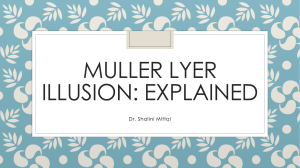
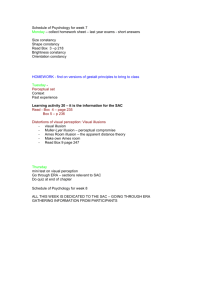
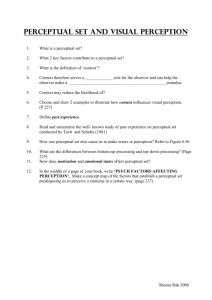
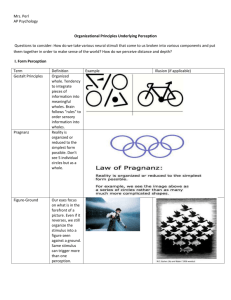

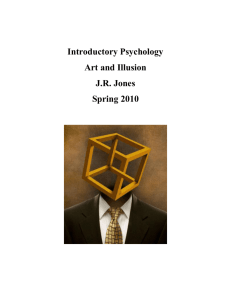

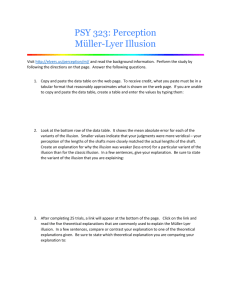
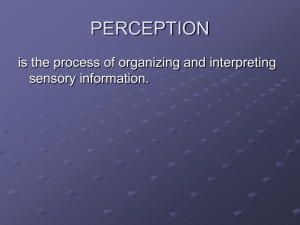
![AP PSych Visual System and Illusions Edited[]](http://s2.studylib.net/store/data/009950776_1-b8cd9619ab229bd9172dad054f824fad-300x300.png)
